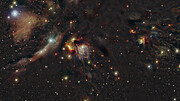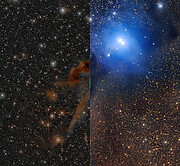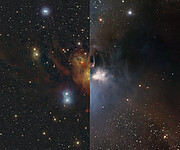Comunicato Stampa
Un telescopio dell'ESO rivela vedute nascoste di vasti vivai stellari
11 Maggio 2023
Usando il telescopio VISTA (Visible and Infrared Survey Telescope for Astronomy) dell'ESO, alcuni astronomi hanno creato un vasto atlante infrarosso di cinque incubatrici stellari nel nostro vicinato unendo più di un milione di immagini. Questi grandi mosaici rivelano giovani stelle in formazione, incastonate in spesse nubi di polvere. Grazie a queste osservazioni, gli astronomi dispongono di uno strumento unico con cui decifrare il complesso puzzle della nascita stellare.
"In queste immagini possiamo rilevare anche le sorgenti di luce più deboli, come stelle molto meno massicce del Sole, rivelando oggetti che nessuno ha mai visto prima", afferma Stefan Meingast, astronomo dell'Università di Vienna in Austria e autore principale del nuovo studio pubblicato oggi su Astronomy & Astrophysics. “Questo ci permetterà di comprendere i processi che trasformano il gas e la polvere in stelle”.
Le stelle si formano quando le nubi di gas e polvere collassano sotto la propria gravità, ma i dettagli di come ciò avvenga non sono del tutto chiari. Quante stelle nascono da una nube? Quanto sono massicce? Quante stelle avranno anche dei pianeti?
Per rispondere a queste domande, l'equipe di Meingast ha esaminato cinque regioni vicine di formazione stellare con il telescopio VISTA all'Osservatorio del Paranal dell'ESO in Cile. Utilizzando la telecamera per infrarossi VIRCAM installata su VISTA, l'equipe ha catturato la luce proveniente dal cuore delle nubi di polvere. “La polvere nasconde queste giovani stelle alla nostra vista, rendendole praticamente invisibili. Solo alle lunghezze d'onda dell'infrarosso possiamo guardare nelle profondità di queste nuvole, studiando le stelle in formazione", spiega Alena Rottensteiner, dottoranda all'Università di Vienna e coautrice dello studio.
La survey, chiamata VISIONS, ha osservato le regioni di formazione stellare nelle costellazioni di Orione, Ofiuco, Camaleonte, Corona Australe e Lupo. Queste regioni distano meno di 1500 anni luce dalla Terra e sono così grandi da coprire un'area enorme in cielo. Il diametro del campo visivo di VIRCAM è pari a tre volte la Luna piena, il che lo rende particolarmente adatto a mappare queste regioni immensamente grandi.
L'equipe ha ottenuto più di un milione di immagini in un periodo di cinque anni. Le singole immagini sono state poi accostate nei grandi mosaici ora mostrati, rivelando vasti paesaggi cosmici. Questi panorami dettagliati presentano chiazze scure di polvere, nubi luminose, stelle appena nate e le lontane stelle della Via Lattea sullo sfondo.
Poiché le stesse aree sono state osservate ripetutamente, i dati di VISIONS consentiranno anche agli astronomi di studiare come si muovono le giovani stelle. "Con VISIONS monitoriamo queste stelle neonate per diversi anni, permettendoci di misurare il loro moto e imparare come lasciano le nubi che le hanno create", spiega João Alves, astronomo dell'Università di Vienna e Principal Investigator di VISIONS. Questa non è un'impresa facile, poiché l'apparente spostamento di queste stelle visto dalla Terra è piccolo quanto la larghezza di un capello umano visto da 10 chilometri di distanza. Queste misure dei moti stellari completano quelle ottenute dalla missione Gaia dell'Agenzia spaziale europea a lunghezze d'onda visibili, per quei luoghi in cui le giovani stelle sono nascoste da spessi veli di polvere.
L'atlante di VISIONS terrà occupati gli astronomi per molti anni a venire. "C'è qui un grande valore duraturo per la comunità astronomica, ed è per questo che l'ESO guida survey pubbliche come VISIONS", dice Monika Petr-Gotzens, astronoma dell'ESO a Garching, in Germania, e coautrice di questo lavoro. Inoltre, VISIONS getterà le basi per future osservazioni con altri telescopi come l'ELT (Extremely Large Telescope) dell'ESO, attualmente in costruzione in Cile e che entrerà in funzione entro la fine di questo decennio. "L'ELT ci consentirà di ottenere immaigni molto ingrandite di regioni specifiche con dettagli senza precedenti, offrendoci una veduta ravvicinata, mai vista prima, delle singole stelle che si stanno attualmente formando", conclude Meingast.
Ulteriori Informazioni
Questo lavoro è stato presentato nell'articolo “VISIONS: The VISTA Star Formation Atlas”, pubblicato da Astronomy & Astrophysics (doi: 10.1051/0004-6361/202245771)
L'equipe è composta da Stefan Meingast (University of Vienna, Austria [Vienna]), João Alves (Vienna), Hervé Bouy (Université de Bordeaux, Francia [Bordeaux]), Monika G. Petr-Gotzens (European Southern Observatory, Germania [ESO]), Verena Fürnkranz (Max-Planck-Institut für Astronomie, Germania [MPIA]]), Josefa E. Großschedl (Vienna), David Hernandez (Vienna), Alena Rottensteiner (Vienna), Joana Ascenso (Universidade do Porto, Portogallo [Porto]; Universidade de Lisboa, Portogallo [Lisboa]), Amelia Bayo (ESO; Universidad de Valparaíso, Cile), Erik Brändli (Vienna), Anthony G. A. Brown (Leiden University, Paesi Bass), Jan Forbrich (University of Hertfordshire, Regno Unito [Hertfordshire]), Alyssa Goodman (Harvard-Smithsonian Center for Astrophysics, USA [CfA]), Alvaro Hacar (Vienna), Birgit Hasenberger (Vienna), Rainer Köhler (The CHARA Array of Georgia State University, USA), Karolina Kubiak (Lisboa), Michael Kuhn (Hertfordshire), Charles Lada (CfA), Kieran Leschinski (Vienna), Marco Lombardi (Università degli Studi di Milano, Italia), Diego Mardones (Universidad de Chile, Cile), Núria Miret-Roig (European Space Agency, European Space Research and Technology Centre, Paesi Bassi [ESA]), André Moitinho (Lisboa), Koraljka Mužiiić (Porto; Lisboa), Martin Piecka (Vienna), Laura Posch (Vienna), Timo Prusti (ESA), Karla Peña Ramírez (Universidad de Antofagasta, Cile), Ronny Ramlau (Johannes Kepler University Linz, Austria; Johann Radon Institute for Computational and Applied Mathematics, Austria), Sebastian Ratzenböck (Vienna; Research Network Data Science at Uni Vienna), Germano Sacco (INAF – Osservatorio Astrofisico di Arcetri, Italia), Cameren Swiggum (Vienna), Paula Stella Teixeira (University of St Andrews, Regno Unito), Vanessa Urban (Vienna), Eleonora Zari (MPIA), e Catherine Zucker (Bordeaux).
L'ESO (European Southern Observatory o Osservatorio Europeo Australe) consente agli scienziati di tutto il mondo di scoprire i segreti dell'Universo a beneficio di tutti. Progettiamo, costruiamo e gestiamo da terra osservatori di livello mondiale - che gli astronomi utilizzano per affrontare temi interessanti e diffondere il fascino dell'astronomia - e promuoviamo la collaborazione internazionale per l'astronomia. Fondato come organizzazione intergovernativa nel 1962, oggi l'ESO è sostenuto da 16 Stati membri (Austria, Belgio, Danimarca, Francia, Finlandia, Germania, Irlanda, Italia, Paesi Bassi, Polonia, Portogallo, Regno Unito, Repubblica Ceca, Spagna, Svezia e Svizzera), insieme con il paese che ospita l'ESO, il Cile, e l'Australia come partner strategico. Il quartier generale dell'ESO e il Planetario e Centro Visite Supernova dell'ESO si trovano vicino a Monaco, in Germania, mentre il deserto cileno di Atacama, un luogo meraviglioso con condizioni uniche per osservare il cielo, ospita i nostri telescopi. L'ESO gestisce tre siti osservativi: La Silla, Paranal e Chajnantor. Sul Paranal, l’ESO gestisce il VLT (Very Large Telescope) e il VLTI (Very Large Telescope Interferometer), così come telescopi per survey come VISTA. Sempre a Paranal l'ESO ospiterà e gestirà la schiera meridionale di telescopi di CTA, il Cherenkov Telescope Array Sud, il più grande e sensibile osservatorio di raggi gamma del mondo. Insieme con partner internazionali, l’ESO gestisce APEX e ALMA a Chajnantor, due strutture che osservano il cielo nella banda millimetrica e submillimetrica. A Cerro Armazones, vicino a Paranal, stiamo costruendo "il più grande occhio del mondo rivolto al cielo" - l'ELT (Extremely Large Telescope, che significa Telescopio Estremamente Grande) dell'ESO. Dai nostri uffici di Santiago, in Cile, sosteniamo le operazioni nel paese e collaboriamo con i nostri partner e la società cileni.
La traduzione dall'inglese dei comunicati stampa dell'ESO è un servizio dalla Rete di Divulgazione Scientifica dell'ESO (ESON: ESO Science Outreach Network) composta da ricercatori e divulgatori scientifici da tutti gli Stati Membri dell'ESO e altri paesi. Il nodo italiano della rete ESON è gestito da Anna Wolter.
Links
- Articolo scientifico
- Fotografie di VISTA
- Per i giornalisti: iscrivetevi per ricevere i nostri comunicati sotto embargo nella vostra lingua
- Per i ricercatori: avete una storia da raccontare? Inviateci il vostro articolo scientifico
Contatti
Stefan Meingast
University of Vienna
Vienna, Austria
E-mail: stefan.meingast@univie.ac.at
Juan Carlos Muñoz Mateos
ESO Media Officer
Garching bei München, Germany
Tel.: +49 89 3200 6176
E-mail: press@eso.org
Anna Wolter (press contact Italia)
Rete di divulgazione scientifica dell'ESO
e INAF-Osservatorio Astronomico di Brera
Milano, Italy
Tel.: +39 02 72320321
E-mail: eson-italy@eso.org
Sul Comunicato Stampa
| Comunicato Stampa N": | eso2307it |
| Tipo: | Milky Way : Nebula : Type : Star Formation |
| Facility: | Visible and Infrared Survey Telescope for Astronomy |
| Instruments: | VIRCAM |
| Science data: | 2023A&A...673A..58M |
soltanto in inglese














